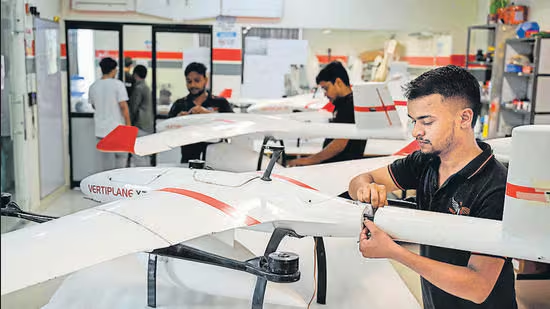Drone Deliveries Revolutionize Urban Logistics In Gurugram

July 01, 2024 – Drones delivering essentials like groceries, medicines, meals, and packages are becoming the new normal in several Gurugram condominiums. Residents, such as those in the Fresco community in Sector 50, appreciate the timely deliveries these machines provide. According to Nilesh Tandon, RWA president of Fresco, drones make around 40 flights daily, delivering over 100 packages and significantly reducing traffic from delivery vehicles.
Skye Air, a Gurugram-based drone delivery company, has partnered with Fresco and other housing societies, delivering about 1,000 packages daily. Ankit Kumar, CEO of Skye Air, emphasizes the advantages of drone delivery, including speed, efficiency, sustainability, and reduced carbon emissions and road congestion. Their drones, capable of carrying up to 5 kg, cover a distance of 2.5 km from their hubs in Sector 30 and Sector 71 to various apartments.
Other companies like Ecom Express and TechEagle are also exploring drone deliveries. Ecom Express delivers 150 to 200 parcels daily in Gurugram in partnership with Skye Air, while TechEagle has run pilots in over 30 cities and started regular operations in locations like Rishikesh, Guwahati, Bilaspur, and several sectors in Gurugram.
TSAW Drones, based in Noida, is focusing on intercity operations. The company, which uses VTOL (vertical take-off and landing) drones, recently partnered with CABT Logistics and is setting up 136 drone hubs across India. TSAW Drones currently operates 27 drones making 75 flights daily between hubs, each covering about 70 km and carrying up to 8 kg. Kishan Tiwari, CEO of TSAW Drones, highlights the cost-effectiveness and environmental benefits of drone deliveries, especially in tier-2 and tier-3 cities where logistics penetration is low.
India’s drone industry has grown significantly under the Drone Rules 2021, which introduced a more liberal regulatory framework. The government has also launched a Production Linked Incentive (PLI) scheme, offering ₹120 crore over three years to establish India as a global drone hub by 2030. The Digital Sky Platform, managed by the Directorate General of Civil Aviation (DGCA), categorizes India’s airspace into red, yellow, and green zones, with permissions required for operations in red and yellow zones.
However, regulatory clarity on BVLOS (beyond visual line of sight) operations remains a challenge. While BVLOS is crucial for intercity cargo delivery, clear guidelines are still needed. Despite regulatory advancements, scaling up intracity drone deliveries in major cities is difficult due to most areas falling under red zones. The industry continues to engage with the government to address these challenges and demonstrate its capability to manufacture drones at scale with necessary fail-safe features.
Do come back to Mavdrones for more Drone Latest News as we bring you the latest updates on advancements in UAV technology and their global impact.
CEO, Mavdrones









